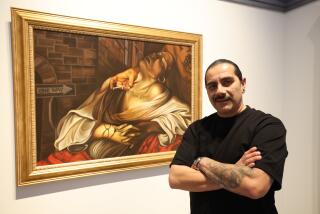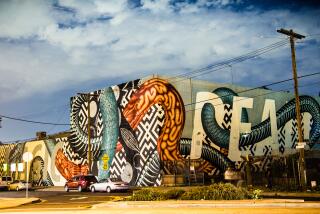O.C. Sees the End of Dobro Era
- Share via
HUNTINGTON BEACH — Original Musical Instruments, which produces the Dobro guitar popular in bluegrass music, is closing its doors and transferring production to Nashville.
About 20 jobs are being eliminated at OMI’s plant in a busy Huntington Beach industrial park, said its parent company, Gibson Musical Instruments. Most workers were sent home with severance checks late last month, but a handful of employees are at work filling outstanding orders.
The plant closing marks the latest chapter in the star-crossed history of OMI, a company that dates to the late 1920s, when John Dopyera, a Czech-born instrument repairman in Los Angeles, set about inventing an acoustic guitar that used internal mechanical means to boost its volume.
While Dobro guitars are best known for their country and bluegrass connections, in the past two years there’s been a surge of interest from rock players, including guitarists with Tom Petty, the Rolling Stones, Sheryl Crow and Joan Osborne.
Gibson’s chief operating officer, David H. Berryman, said Monday that Dobro production will be consolidated with that of other bluegrass instruments at a plant near its headquarters in Tennessee.
Most of the plant’s employees were offered jobs in Nashville, Berryman said, but it was uncertain how many would move.
Berryman said that Gibson hopes the switch will improve the quality of the instruments by incorporating new processes that “just wouldn’t have been cost-effective” at the tiny facility in Huntington Beach.
Gibson didn’t disclose OMI’s financial performance, but music industry observers said the plant has been shipping about 50 instruments each week, and that revenue had risen from about $300,000 a year when Gibson acquired the small company in 1993 to about $1.5 million annually.
*
Resophonic guitars, which use mechanical means to increase the volume of what’s being played, represent just a tiny fraction of the multibillion-dollar music industry. But Dobro--which often is mistakenly used as a generic name--has a storied history.
Dopyera, along with brothers Rudy and Ed--Dobro is short for Dopyera Brothers, and, in a bit of serendipity, is the Czech word for “good”--created an internal system that uses metal cones and a special string bridge to increase volume.
The Dopyeras succeeded and the Dobro guitar quickly became a favorite. But the instrument’s heyday was remarkably short. Within a few years, guitarists were being courted by companies offering more powerful electric guitars.
The brothers stopped production entirely during World War II and didn’t resume manufacturing until 1958, when they opened a new shop in El Monte. In 1967, the brothers formed Original Musical Instruments in Long Beach. That company moved to Huntington Beach in 1976.
Remaining Dopyera family members, including a sister, Gabriela Lazar, who’s now in her 90s, sold their interest in the business to the company’s accountant in November 1985. After that sale, industry sources said, the company’s quality and production levels slipped. Gibson purchased the company in 1993.
*
Recent visitors to the small plant in Huntington Beach said that OMI employees continued to use many of the production techniques that the company’s founders used in the 1920s and 1930s.
The reliance upon aging production methods was viewed as a curse and a blessing. Sticking with the old methods ensured that the original instruments could be replicated--but the company failed to improve the sound.
Generally, only experienced players have an interest in--or can afford--the unique-sounding instruments, which retail for between $800 and $3,000.
Industry observers said that, under General Manager Michael Replogle, OMI had started to revamp some of its production methods, as well as introduce new instruments that are better suited to today’s musicians.
But observers also said that an anticipated cash infusion from Gibson, one of the music industry’s giants, never occurred.
*
Word of the company’s demise has spread quickly through the tight-knit instrument manufacturing and retail world.
“It’s sad because we definitely were seeing improvements in recent years,” said Eddie Montana, co-owner of Montana & Lace Vintage Musical Instruments, a retail shop in Huntington Beach. “Their manufacturing techniques were improving, and they were talking about building a Dobro mandolin and ukulele.”
While Gibson is known for quality instruments, industry observers questioned whether the big company would be able to capture the sound of instruments manufactured in the small plant in Huntington Beach.
“It’s the typical clash of a big corporation and the entrepreneurial company,” one music industry executive said. “Players are loyal to the brand because of that special sound. . . . They’re not going to accept a lesser sound.”
(BEGIN TEXT OF INFOBOX / INFOGRAPHIC)
Quality Sound
The Dobro guitar was designed more than 70 years ago and hasn’t changed since. The line now includes banjos. Details on Dobros:
* What’s a Dobro?: Type of guitar developed in the 1920s by John Dopyera, a Czech-born owner of a musical instrument repair shop in Los Angeles.
* How it works: Based on a system of three aluminum cones, connected to a string bridge by a sound bar and amplified by a round metal plate that replaces most of the face of the guitar.
* How it got its name: Dopyera and his brother, Rudy, produced and sold the guitars in their shop. “Dobros” is a simple combination of the words “Dopyera” and “brothers.”
WHO PLAYS A DOBRO
Some musicians favor Dobros for their louder, brighter sound. They are especially popular with country and bluegrass artists. Dobro players include:
* John Denver
* Barbara Mandrell
* Mark Knopfler (Dire Straits)
* Willie Nelson
* Ricky Skaggs
Source: Times reports; Researched by JANICE L. JONES / Los Angeles Times
Los Angeles Times
More to Read
Inside the business of entertainment
The Wide Shot brings you news, analysis and insights on everything from streaming wars to production — and what it all means for the future.
You may occasionally receive promotional content from the Los Angeles Times.










